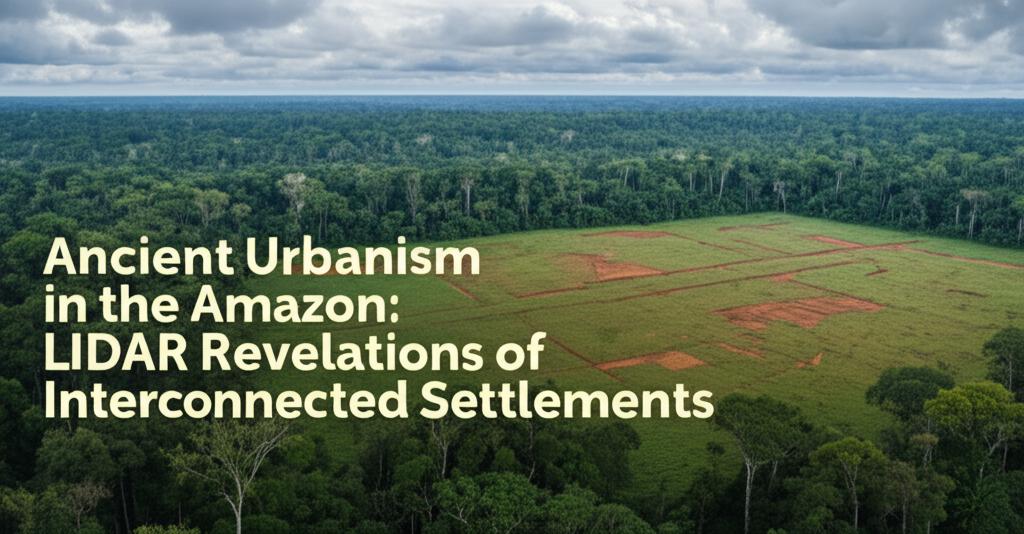Recent advancements in Light Detection and Ranging (LIDAR) technology have revolutionized our understanding of ancient civilizations in the Amazon rainforest, revealing extensive, interconnected urban settlements that challenge long-held beliefs about the region's past.
For centuries, the Amazon was widely considered a vast, untouched wilderness, inhabited primarily by small, scattered groups. However, LIDAR, which uses laser pulses to map terrain and create detailed 3D models, has enabled researchers to peer beneath the dense forest canopy. This technology has unveiled surprisingly large and complex urban centers, sophisticated agricultural systems, and extensive road networks, indicating that the Amazon was home to advanced societies for millennia.
Key Discoveries and Insights:- Vast Networks of Settlements: In Ecuador's Upano Valley, LIDAR scans have uncovered a 2,500-year-old network of cities and towns. This urban landscape, older than some Roman-era cities in Europe, includes over 6,000 earthen platforms, likely for homes and ceremonial buildings, arranged in geometric patterns. These settlements, spanning hundreds of square kilometers, were interconnected by a complex system of roads, some stretching for over 12 miles (20 kilometers) and up to 33 feet (10 meters) wide. It's estimated that these urban centers could have supported tens of thousands of people.
- Sophisticated Engineering and Agriculture: The LIDAR data reveals evidence of advanced engineering, including raised causeways, canals for water management and drainage, and terraced farmlands. These features demonstrate a high level of societal organization and an ability to significantly modify the landscape to support large populations. The presence of these structures suggests intensive agricultural practices, including the cultivation of crops like maize, beans, manioc, and sweet potatoes.
- Early Urbanism: The findings in the Upano Valley and other areas, such as the Llanos de Mojos in Bolivia, point to some of the earliest known examples of urbanism in the Amazon. Some of these settlements date back as far as 500 BCE. These discoveries are pushing back the timeline for complex societies in the region and highlighting the diversity of cultures that once thrived there.
- "Garden Cities": Some researchers describe these Amazonian settlements as "garden cities," characterized by a dispersed layout of buildings integrated with agricultural areas. This model of "green urbanism" reflects a unique adaptation to the rainforest environment.
- Widespread Earthworks: Beyond specific city sites, LIDAR surveys have indicated the potential existence of tens of thousands of pre-Columbian earthworks throughout the Amazon basin. These range from fortified villages and ceremonial sites to agricultural mounds and riverine settlements. Even a relatively small percentage of the Amazon surveyed with LIDAR has yielded a significant number of new site discoveries.
- Challenging Previous Assumptions: These discoveries fundamentally challenge the notion of the Amazon as a "pristine wilderness" untouched by human influence. Instead, the evidence points to a "cultural landscape" shaped by human activity over thousands of years. Early European accounts of populous cities in the Amazon, once dismissed as exaggerations, are now being reconsidered in light of this new archaeological evidence.
LIDAR technology has been a game-changer for Amazonian archaeology. The dense vegetation made traditional ground surveys incredibly time-consuming and often ineffective for identifying large-scale settlement patterns. LIDAR allows researchers to quickly and accurately map vast areas, digitally "removing" the forest canopy to reveal the underlying topography and human-made structures. This has dramatically accelerated the pace of discovery and is leading to a re-evaluation of the Amazon's pre-Columbian history.
While LIDAR provides a crucial overview, it is often complemented by traditional archaeological excavations to confirm findings, gather artifacts, and understand the daily lives of the people who inhabited these ancient settlements.
The ongoing LIDAR revelations continue to underscore the rich and complex history of human habitation in the Amazon, demonstrating that it was a region of significant innovation, large populations, and interconnected societies long before European arrival. This emerging picture highlights the importance of preserving not only the ecological but also the vast archaeological heritage of the Amazon.

